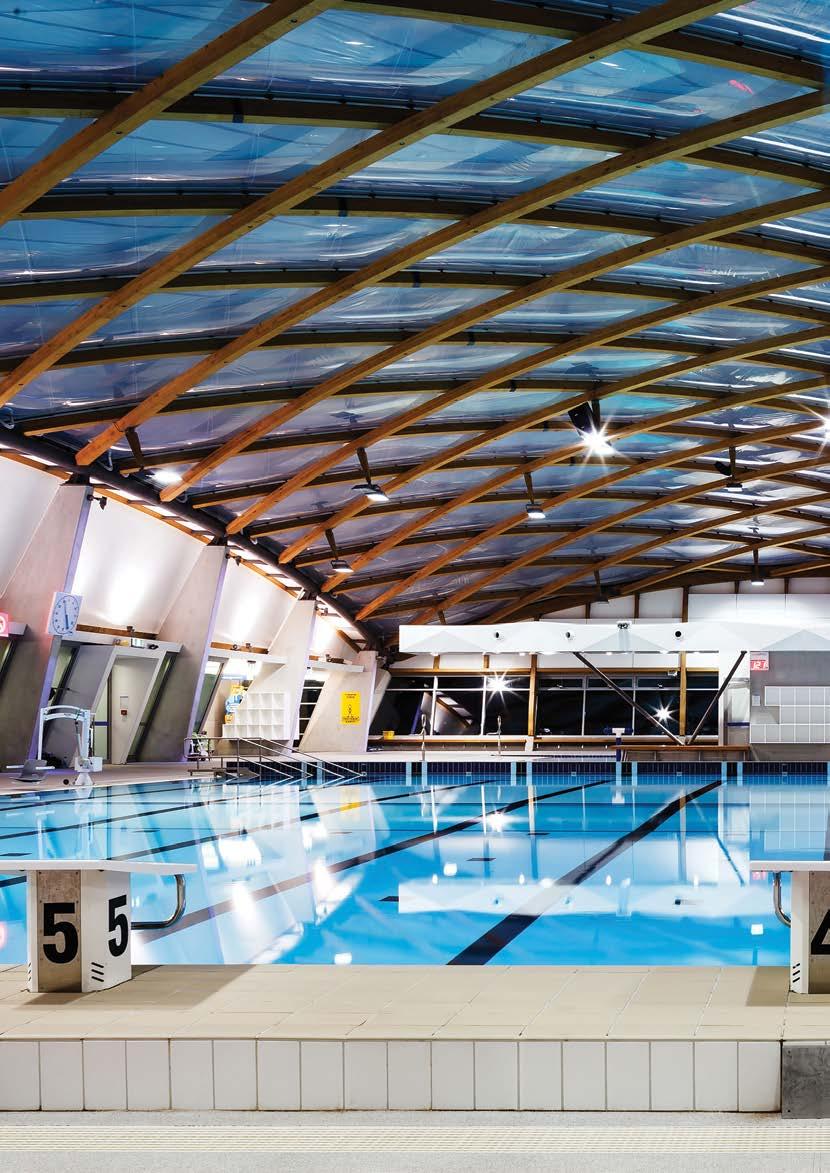
14 minute read
Cover Feature: Myrtha Pools
The Rise of Modular Pool Technology
The use of modular technology is increasing exponentially across all sectors of the construction industry. Pre-manufactured, modular components often offer cost and construction programme savings, while at the same time, offering improved quality control due to the manufacturing process being completed within a controlled environment.
Advertisement
In terms of modular technology, the aquatic industry is no exception.
Myrtha Pools have been the market leader in modular technology for swimming pools for decades. Between Australia and New Zealand there are now in excess of two hundred individual Myrtha Pool installations and literally thousands of Myrtha Pools spread throughout over seventy countries worldwide.
The company was established in 1962 as a family business. After steady growth over the first 15 years, the business acquired the Myrtha technologies German patent in 1977. This technology, which is the process of laminating thin low plasticizer PVC material to stainless steel sheet, was the technology that started a revolution in how commercial modular swimming pools were to be manufactured and installed.
Through steady growth and modernisation of the manufacturing process, based on a CAD/CAM process, Myrtha Pools went on to construct their first major competition pool for the 1987 European Championships. In 1996, Myrtha Pools supplied and installed their first Olympic Games swimming pool, which was a water polo pool at the Atlanta Olympics. These initial high profile installations have been followed by many more pools for both the Olympic Games and FINA World Swimming Championships around the world.
Innovation and product development have been key to the success of Myrtha Pools, and the product that is manufactured today - while
Modular Pool Technology
still similar in many ways - is greatly evolved from the early pools that the company produced. Today the Myrtha wall panels and gutters are manufactured from AISI441 grade stainless steel that is factory laminated with a hard PVC material, with a shore hardness of A97 and low plasticiser content. All structural supports, including the base frame, are formed from AISI470 Stainless Steel. For maximum quality control, all panels are folded and punched in accordance with the CAD design specific to each project. Welding is excluded from the manufacturing and installation process, due to the risk of localised corrosion in the weld area.
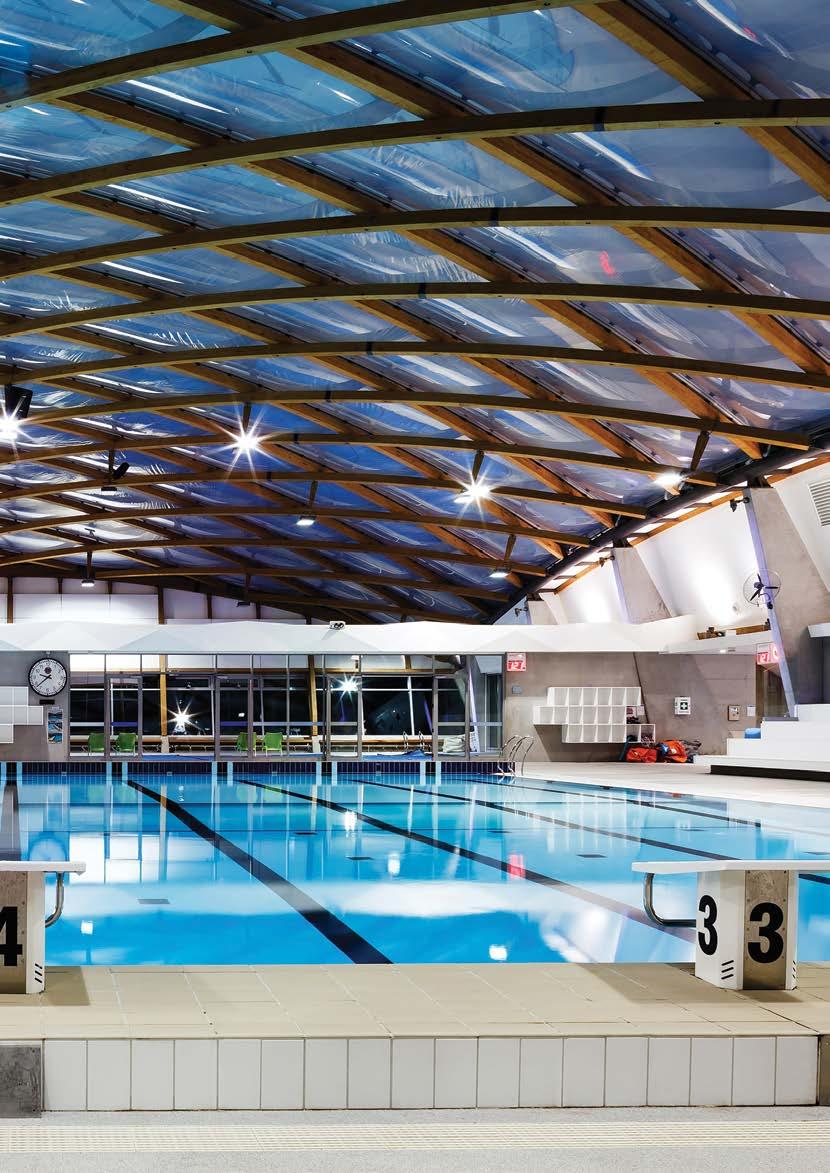
Once prepared and delivered to the site, the materials are assembled on-site by Myrtha trained installers. Every component of a Myrtha Pool is mechanically secured, making for a very fast assembly and a high-quality finish. Water proofing is achieved through a combination of liquid PVC sealing to panel joins and flexible PVC bandages. The floor is finished with a 2.2mm thick reinforced PVC membrane, which is heat welded to the wall panels ensuring a fully watertight pool structure. The result is a light weight and durable pool structure that is, in most cases, cheaper and faster to construct than traditional concrete construction methods. Maintenance is minimal - and when maintenance is required, it can often be carried out without the need to empty the pool.
Although best practice would indicate emptying pools every 7 to 10 years, there are many examples of Myrtha Pools that haven’t been emptied for 15 to 20 years.
With a structural warranty of 25 years (expected operational life of 50+ years) and a water tight guarantee of 10 years (extended to 15 years when an annual maintenance inspection is carried out) a Myrtha Pool offers a modern alternative to traditional construction methods.
Why Choose Myrtha Pools for your Next Aquatic Project or Refurbishment? The reason for the success of Myrtha Pools around the world, is due to their ongoing commitment to provide the best possible technology for swimming pool construction. With a fully dedicated R&D department continually testing and improving their technology, Myrtha Pools continue to break new ground in providing cutting edge solutions for both new pools and the refurbishment of existing concrete pools. So why choose Myrtha?
World Class Technology Myrtha Pools lead the world when it comes to modular aquatic technology. This is proven by our long-standing relationships with FINA where we regularly provide pools (both permanent & temporary) for major events such as the Olympic Games & World Championships.
Reduced Risk A Myrtha Pool comes as a complete package with very few complementary trades required to complete the installation. The end result of this is a single point of responsibility for the entire pool tank. When combined with a Myrtha Distributor also installing the filtration pipe work then all the risk associated with the pools is combined into one contract. This eliminates finger pointing as soon as a defect comes up which can happen with other construction methods.
Minimal Maintenance Unlike traditional construction, Myrtha Pools do not require a significant maintenance schedule. Sturdy, built to last and not subject to dimensional variations, a Myrtha structure is not susceptible to cracking or structural deterioration, and is not affected by the aggressive action of chlorinated pool water. A simple annual maintenance check can be carried out without the need for a pool closure, and only takes a few hours per pool. Many maintenance procedures can also be carried out without the need to empty the pool, saving on water costs and substantial shut down periods.
The Myrtha modular pool at MSAC was constructed for the 2006 Commonwealth Games.
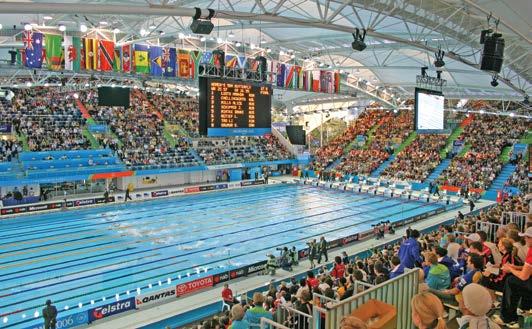
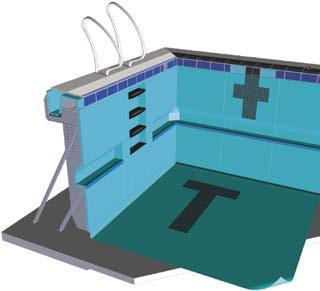
Strong Manufacturer’s Warranty Swimming pools built using Myrtha Technology have a design life of 50+ years, due to the inherent structural integrity and the proven characteristics of the materials employed.
The RenovAction Installation Process
RenovAction technology from Myrtha Pools provides an option to modernise an existing pool without the expense associated with demolition and reconstruction. The installation process is both simple and fast, and has been developed minimise the risk of issues or delays occuring during the renovation process.
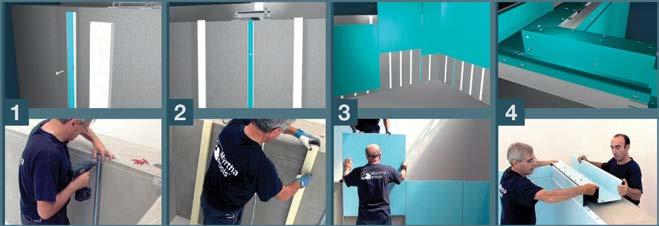
Rail Installation Spacer Installation Panel Installation Overflow Gutter Installation The existing surface of the pool is commonly left untouched. Stainless steel rails are aligned and affixed to the pool wall prior to panel installation. High density foam spacers are installed between each rail to avoid any bending of the panel. The spacers allow for a high degree of installation precision. They are glued to the concrete wall and trimmed to panel level using a high temperature electric cable. Wall panels are inserted into the pre-aligned rails. Special corner pieces, which are the starting point for the RenovAction installation, are manufactured and installed. The overflow gutter is installed on steel supports which are anchored to the existing concrete. The gutter is manufacturered with Myrtha stainless steel, and is able to be installed at adjustable heights and with a transversal sloping angle.
The advanced technological features of the modular system allow Myrtha to confidently provide one of the best warranties worldwide - a 25-year structural warranty and 10-year watertight guarantee (extended to 15 years with an annual maintenance agreement). Because Myrtha Pools is an international brand with a global reputation to uphold, the warranty sits directly with Myrtha and not with our distributor - ensuring the security of the client regardless of what happens with our distributors.
Fast Installation Myrtha pools can be built in a very short time, thanks to their pre-engineered design. The components are manufactured according to ISO 9001 quality standards through an automated process and shipped directly to the building site. This facilitates a timely installation process that does not require the use of heavy equipment and significantly reduces the risk of assembly mistakes on the construction site. Because the construction process for a Myrtha pool is very short relative to traditional construction, significant cost savings can be achieved within the construction program.
Light Weight Structure A Myrtha Pool is constructed using a lightweight Stainless Steel structure. All the transitional load is dispersed through an engineered footing with no load transferred through the pool floor. This allows for a significant reduction in the complexity of the concrete floor beneath the pool, resulting in significant cost and time savings associated with the concrete works.
Myrtha technology is also ideal for unstable grounds with less direct loading on the ring foundation and adjustment built into the panels to compensate for any ground movement.
Millimetric Precision A comprehensive design developed with 3D Revit software allows for a highly detailed review of the finished pool structure and better control of the overall material completeness. The tri-dimensional design software aides in the customized manufacturing process and automatically generates a complete, error-free material list. Myrtha pools millimetric precision exceeds F.I.N.A. regulations and competition facility rules.
Fixed Costs Building a Myrtha pool means fixed purchasing investments and predictable whole-of-life costs. A shorter installation time compared to traditional concrete construction also significantly reduces the risk of cost overruns. In addition, as there is a single contract for the construction of a Myrtha pool, there is also less risk of cost variations due to conflicts between trades.
Also, unlike traditional construction, Myrtha pools do not require a significant maintenance schedule. In the event of a maintenance closure, the time frame associated with these works is generally significantly less than traditional construction methods.
Refurbishment using Myrtha Myrtha Pools technology could provide the answer to local councils looking for cost effective options to save the many memorial swimming pools across Australia. RenovAction technology by Myrtha Pools provides an option to modernise an existing pool without the expense associated with demolition and reconstruction.
Memorial swimming pools are an iconic feature of most councils’ aquatic infrastructure. While in many cases these pools are structurally sound, they often have issues with leaking or outdated circulation that no longer meets health regulations.
In the past, this has left Councils with the choice of either repairing the pool structure and internal finishes (which in most cases is only a short-term solution) or replacing the pool with a completely new structure.
The Myrtha Pools RenovAction technology, offers an exciting alternative to traditional short term repairs or complete replacement.

Panel Sealing Joint Protection Finish InstallationFloor Covering with Reinforced PVC Membrane Once installed, the entire structure is waterproofed with a combination of semi-rigid PVC profiles and a special Myrtha sealant, which is applied to the joints of the wall panels, guaranteeing a perfect weld on the entire surface. Reinforced PVC tape is welded to the gutter joints to ensure additional waterproofing. The floor is lined with a special reinforced PVC membrane. The membrane is supplied in rolls which are hot welded together at the seams. The wall panels and the floor are joined together by a PVC profile, which is also hot-welded to the walls and the floor. Ceramic tiles are applied on the top of the Myrtha surface for a clean and elegant finish. Adhesion of tiles to a Myrtha stainless steel surface is much easier and safer than to a concrete surface, as there is no possibility of water penetration beneath the tiled surface.
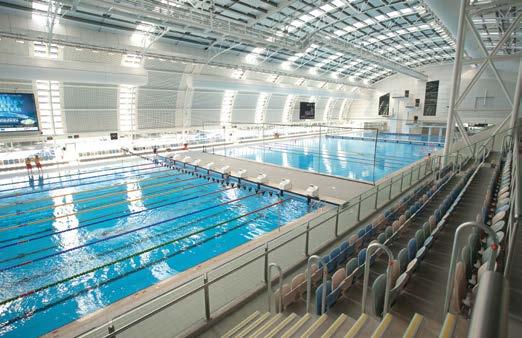
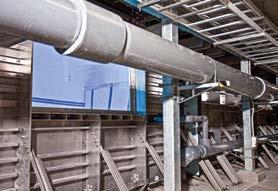
Myrtha Pools patented and exclusive RenovAction technology has been specifically developed for the refurbishment and modernisation of existing concrete pools. RenovAction technology utilises a modular Stainless Steel panel system incorporating three main items – the pool walls, the pool floor and the overflow gutter. The pool walls are modular panels of AISI 441 grade stainless steel, laminated at 300 degrees with a hard PVC surface on the inner swimming pool face. The lamination process permanently bonds the PVC to the steel and forms a product with the strength and integrity to be mechanically processed and bent in excess of 180 degrees without affecting the integrity of the PVC membrane. The panels are attached to the existing pool walls by anchor clamps and expansion screws.
As the pool floor is not subject to the same stresses as the walls, it is more economical and practical to use a specially engineered reinforced PVC membrane with high density and tensile strength. The membrane is supplied in rolls and heat welded on site to form a continuous watertight system from pool floor to walls.
Prince Alfred Park, Sydney From above, the pools at the Marion Aquatic Centre in suburban Adelaide would appear to the untrained eye, to be no different to any other large competition pool. The view from below ground (pictured left) shows the pool’s engineered stainless steel panels and supports.
The overflow gutter is formed using the same AISI 441 grade stainless steel panel laminated with hard PVC. It is folded to form a modular ‘wet deck’ gutter system, complete with ABS channel grating. This gutter is installed by means of anchor clamps and expansion screws onto an existing concrete pool wall which has been cut and prepared to the appropriate profile with the surrounding concourse, then formed up to the back of the gutter to provide a seamless ‘wet deck’ finish to the pools edge.
RenovAction technology by Myrtha Pools offers a cost effective, yet durable long-term solution to refurbishment of existing concrete swimming pools. The installation process is extremely quick when compared to a traditional refurbishment or replacement, and delivers a high quality result thanks to the prefabricated nature and the fact that the system is manufactured in a controlled environment under an ISO 9001 quality assured certification process.
Whole-of-Life Costs One of the key advantages of the Myrtha Pools system is the very low whole-of-life costs that are associated with a Myrtha Pool relative to traditional construction. This is in part due to strong warranty terms that guarantee if an issue was to arise with the product within the warranty period, then this work is most likely going to be covered under warranty.

14 Construction Engineering Australia • Feb/Mar 2020 Australia’s first Myrtha modular pool was constructed in Perth for the 1998 FINA World Championships.

The structure of a Myrtha Pool, while under guarantee for 25 years, has an anticipated life of 50+ years under normal aquatic environments. There is very little maintenance required with the steel structure of the pool during this time.
The waterproofing system within the pool structure (PVC membrane) has an expected life expectancy of 20 years, although there are many cases around the world of Myrtha pools more than 20 years old which still have their original membrane in use.
Due to the fact that there are only minimal amount ceramic tiles used in a Myrtha Pool (in some cases no ceramics at all), and that we recommend the use of an epoxy grout system, there is only minimal maintenance required to the ceramic surfaces on a Myrtha Pool.
The largest maintenance exercise with a Myrtha pool is the replacement of the PVC membrane. In order for this membrane to be replaced, the pool needs to be emptied and all existing membrane removed. The time-frame associated with this task varies depending on the size and design of the pool, but for a typical 50m pool this is expected to take 4 weeks from closure of the pool to re-opening again. The end result of this exercise is a near new appearance to the swimming pool and a renewed watertight guarantee.
For more information about the whole-of-life costs for a Myrtha Pool, please contact a Myrtha representative.

There has been a lot of misleading information circulated in Australia regarding the whole-of-life costs of modular pools in recent years, with claims that it can cost upwards of $300,000 to refurbish a Myrtha pool.
The oldest Myrtha Pool in Australia - at HBF stadium in Perth - was refurbished in its entirety at a cost of around $180,000. This included replacement of all water line tiles and complete replacement of the PVC membrane - including relining the gutters. Importantly, a new water-tight guarantee was provided upon conclusion of the refurbishment. There are also a number of examples of pools that are greater than 20 years old that haven’t required any significant maintenance whatsoever.
Reduced Carbon Footprint In an effort to lower their impact on Climate Change, Governments around the world are looking to reduce their CO2 emissions. A Myrtha Pool offers a significantly lower carbon footprint than traditional construction and the majority of materials used in the construction of a Myrtha pool are easily recyclable.
Myrtha Pools commissioned Australian engineering company ACOR Consultants to compare the energy used in building a Myrtha Pool versus a traditional concrete tank. Such quantity of energy is expressed as the ‘Carbon Footprint’, that is the quantity of CO2 which corresponds to the energy necessary for the production of the materials used.
While the savings on emissions obviously depend on the project’s dimension and shape(s), using the classic example of competition pools measuring 25x25x2 m and 50x25x2 m, the carbon emissions generated as part of the Myrtha pool’s construction are approximately 49% and 53% less than a traditional concrete pool. There are also significant environmental benefits in the reduction of water consumption during the build.
Myrtha Pools are also currently the only pool manufacturer to achieve LEED certification. For further information, please visit: www.myrthapools.com
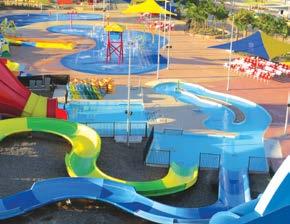
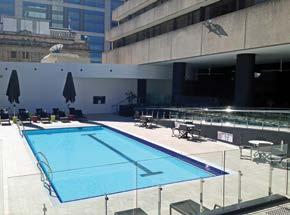
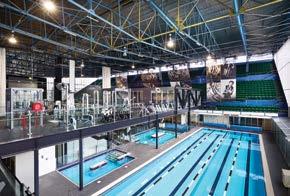
FROM TOP: Hilton Hotel, Brisbane: Myrtha modular technology is ideal for rooftop pools. Wet ‘n Wild, Sydney: Myrtha modular technology allows for a wide variety of pool designs. Collingwood Football Club Training Facility, Melbourne










